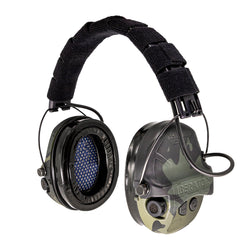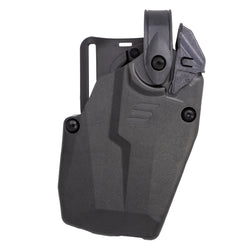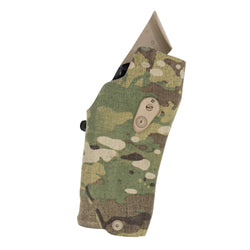Many gun manufacturers offer “tactical” versions of their standard handgun models. A “tactical pistol” sounds cool and implies capabilities not offered by more pedestrian civilian-themed guns.
But what makes a handgun “tactical?” Is it certain features or enhancements that lend themselves to military or law enforcement use? Or is the “tactical” appellation mostly a marketing tool aimed at certain shooters and sometimes used to jack up the gun’s price?

Let’s examine those possibilities, which are perhaps more nuanced than you might think. Then we’ll offer a different perspective on what “tactical” means in the real world and how it applies to different shooters.
“Tactical” Pistol Features
Look at any “tactical” model handguns, and they will likely share certain features like a threaded barrel and suppressor-height sights. They will also likely be optic-ready. Some may have night sights, a more durable Cerakote finish, enhanced grip panels, or an enlarged trigger guard for gloved use. A lighter, smoother trigger may also make the list, as might ported slides and fluted barrels to reduce weight.
But times change and technology evolves, as do customer expectations. “Tactical” designation or not, I might not buy a modern semi-auto handgun that wasn’t optic-ready. I recently had two older pistols, a Walther PPQ and PPS, milled to accept optics. Does that make them “tactical?”

Twenty years ago, many would have considered an accessory rail and ambidextrous controls to be “tactical” features.” Now, a handgun without a rail is an anomaly, and probably a poor design choice. Ambidextrous, or at least reversible, controls are becoming more standard on all pistols.
Gunmakers also recognize that shooters like large trigger guards since even civilians use gloves. Good grip panels that once would have qualified as “enhanced” adorn most models. They may not be fancy, but they provide solid purchase in poor conditions.
Tough, weather and wear-resistant finishes are also standard. Night sights are no longer rare, and many inexpensive pistols, like my Ruger Max 9, come optic-ready with standard tritium fiber optic sights. That leaves us with threaded barrels, suppressor-height sights, and weight-reduction options like porting or fluting.
Does running a suppressor and the necessary sights make you an operator, or simply a shooter who values hearing protection?
Do porting and fluting make you a door kicker? Or does it just look cool?
And there lies the nuance. Gun features don’t define the shooter. Rather, shooting philosophy defines the features each shooter needs or wants.

“Tactical” Philosophies
As a shooter, I’m primarily interested in hunting and self-defense applications. I went through my “tacticool” phase, which was quite valuable. It exposed me to various features and accessories with which I had little experience, demonstrating their utility and how they could help me be a better shooter. It also taught me which features and accessories are not necessary for my situation and perhaps even a hindrance.
Those experiences taught me to define “tactical” by shooter philosophy rather than gun features. My philosophy differs from that of the local SWAT guy or competition shooter, and probably from many other concealed carriers. Hanging a weapon light on my carry and home defense pistols is tactically sound, though some will justifiably argue that a handheld light is a better choice.

I like having a threaded barrel on my home defense pistol since it allows me to add a suppressor. That gun, an IWI Masada Tactical, also has the prerequisite suppressor-height sights. But I don’t want a threaded barrel or taller sights on my carry guns since they can impede a faster, smoother draw. They serve no purpose anyway, since I don’t want a suppressed carry gun. So, in that case, not having those features is a “tactical” decision. Both guns wear an optic since that makes sense to me for both applications.
I also attend defensive shooting courses, which contain certain “tactical” elements. The guns I use for those generally have an optic but lack threaded barrels because I don’t suppress pistols in that situation, much like my concealed carry philosophy. Does that mean those guns aren’t “tactical” in that environment? Certainly not.
Do You Need a “Tactical” Pistol?
Yes, you do. The trick is recognizing which pistols, and which features, fit your “tactical” profile. One definition of “tactics” is “any mode of procedure for gaining advantage or success.”
“Tactical” can also be defined as “of or relating to a maneuver or plan of action designed as expedient toward gaining a desired end or temporary advantage.”

So, a “tactical” pistol is any handgun designed to maximize your chance of advantage or success in a given endeavor. It’s up to you to determine what that looks like and what features further that goal of success. My carry guns are set up differently than my home defense gun. My hunting sidearm, a .357 Magnum Ruger Blackhawk, is different from both of those. But each is tactically sound for its role.
Speaking of revolvers, Taurus now features its optic-ready TORO models. Smith & Wesson offers the ROC conversion kits for certain wheel guns. It just depends on what you want and need. It admittedly looks strange, but an optic-equipped revolver could be an attractive option for some folks.
A Final Word About Tactical Pistols
I’ve gone on about setting up your pistols to succeed in the roles you assign them. I firmly believe in that approach. But I also believe that gun ownership and shooting are supposed to be fun. If you want a custom pistol with all the bells and whistles, ported slides, colored threaded barrels, bayonet lugs, grenade launchers, or whatever else you can dream up, I say go for it.
Drive on, brothers and sisters. I recently ran a very cool custom Glock 45 from Danger Close Armament that checks most of those boxes while still being an awesome carry or home defense gun. It’s not all strictly necessary, but it sure makes for a very capable, nice-shooting handgun. Which brings me to a final point.

I can justify a purpose for most of my guns, but I have plenty just because I want them. They don’t necessarily have to occupy a slot in my system, though the Danger Close gun definitely would if it belonged to me. Those guns look good (to me anyway). They’re fun. They’re cool. Maybe they’ll even attract a gun bunny or two (not likely at my age).
If you dig being tacticool, then own it. There are plenty of sweet pistols out there to get you started. Just remember that being a fun gun is still a role, and fun guns aren’t always the best guns in the real world.









